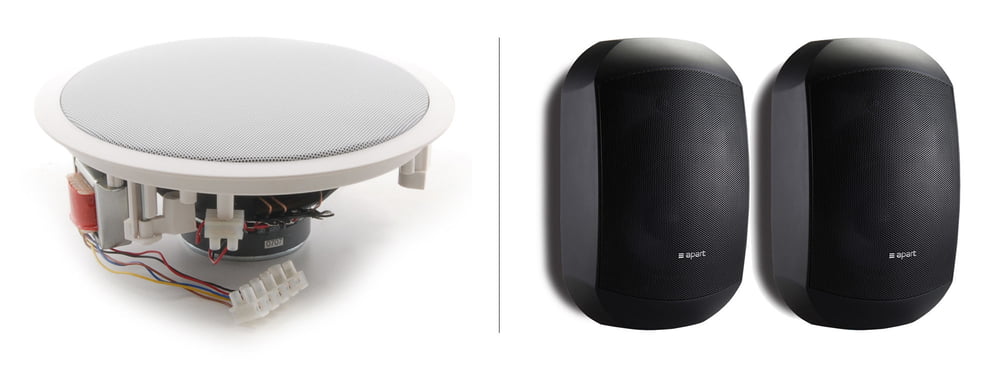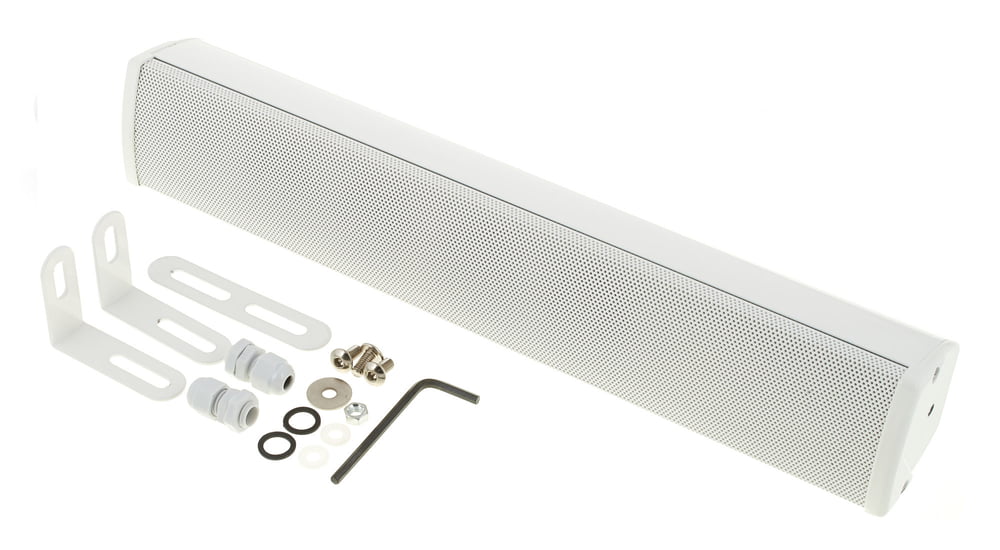6. Speakers
They are the last link in the sound transformation chain and may be the most important 100V PA system components.
To give you an overview at least of the vast range of 100V PA system speakers available, I have put together a list of four distinguishing criteria and given a number of examples in each category.
The criteria are:
- a) output (RMS = Root Mean Square/quadratic mean)
- b) sensitivity
- c) construction type, emission characteristics
- d) installation and / or installation site
on a)
The power rating on various speakers frequently make you want to laugh. One reliable measurement is RMS, which corresponds to the quadratic mean. In arriving at this measurement, the speaker's continuous performance over the entire frequency range is ascertained.
If you encounter very impressive power ratings that do not come with any further specification, you're probably reading about peak power, which the speaker is required to deliver only for two seconds - and which is therefore not a reliable measurement.
on b)
A very good indicator of a speakers effectiveness is the efficiency factor, also known as sensitivity. This is standardized and is indicated in sound pressure in dB. It is ascertained by supplying a speaker with 1W of power and determining the sound pressure with a measurement mic positioned 1 metre away.
Thus, a specification could read "96 dB / W /m".
This would mean that at a power supply of 1 Watt, the speaker's sound pressure at 1 metre distance is 96 dB - which, by the way, would be more than acceptable in a PA woofer. A tweeter horn will most likely have a higher output; you may well encounter values of 115 dB, for example!
What we must also say is that you need to double the power in order to increase the sound pressure by 3 dB. Thus, if you have two speakers with a difference of 6 dB (e.g. 96 dB to 102 dB), the lower-efficiency speaker requires four times the power to compensate for this difference in efficiency!
Summarized in a convenient table, this is what we get:

output - sound pressure
zu c)
A speaker's construction type and the sound emission characteristics are crucial with 100V PA systems, of course. They are often included in a speaker's spec sheet. However, I would like to stress once more the fact that we cannot expect a linear and finely balanced sound as we would expect from a studio monitor. Rather, we will find a wide variety of construction types and emission characteristics, due to the fact that the purpose of 100V PA systems is often the transmission of spoken word information, and often in acoustically difficult environments, such as churches.
Typical specs for a 100V PA system speaker my be:
Equipped with: 1x 8" LF, 1x 3/4" HF, emission angle: 90° h x 70° v
This means:
- two speakers
- 8-ich diameter woofer,
- ¾-inch diameter tweeter
- emission area 90 degrees horizontal, 70 degrees vertical
on d)
Finally, you have to take the installation type and place into account in your considerations.
For example, if you want to recess your speakers into the ceiling, you need to observe the speakers' mounting depth (cavities) and the thickness of the ceiling.
If you go for wall mounting, you'll need suitable brackets, of course.
If the acoustic conditions are difficult, your speaker needs to have a corresponding frequency range.
If you install the speakers in an outside area without a roof or cover, you need to go for weatherproof speakers, which furthermore need to have a good transmission rate. Basically, only speakers with compression drivers are suitable in this context.
In the following you will find some examples of speaker types.
Indoors, ceiling or wall mounting, moderate output

order code 210244 the box pro CMX20-T-W and order code 427057 Apart MASK4CT
Indoors, flexible positioning, higher output

order code 155735 EV Evid 4.2 T and order code 411595 Bose FreeSpace DS 40SE VA
Indoors, difficult acoustics

order code 212018 Thomann MTS3C-100V

order code 167083 the box pro MPLT 32
Outdoors, greater output (PA system)

order code 387852 the box i208








